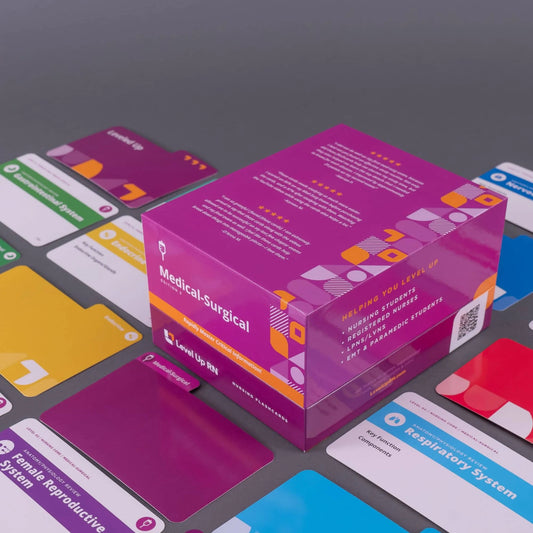Med-Surg - Nervous System, part 13: Traumatic Brain Injury
Updated: Cathy ParkesTraumatic brain injury (TBI). The pathophysiology of a TBI, including the primary AND secondary injury that occurs with a TBI. The signs/symptoms, diagnosis, and treatment of a TBI. The nursing care and teaching for a patient with a traumatic brain injury, along with the complications of a TBI. These complications include: brain herniation, hemorrhage/hematoma (epidural hematoma, subdural hematoma, intracerebral hemorrhage), hydrocephalus, and SIADH.
Full Transcript: Med-Surg - Nervous System, part 13: Traumatic Brain Injury
Full Transcript: Med-Surg - Nervous System, part 13: Traumatic Brain Injury
Hi, I'm Cathy with Level Up RN. In this video, we are going to talk about traumatic brain injury. And at the end of the video, I'm going to give you guys a quiz. So definitely stay tuned for that so you can test your knowledge of some of the key facts I'll be covering in this video. And if you have our Level Up RN Medical-Surgical Nursing Flashcards, definitely pull those out so you can follow along with me.
With a traumatic brain injury or TBI, we have a disruption in brain functioning due to a trauma. And this trauma causes a primary injury, which can include shearing, destruction of brain tissue, and/or hemorrhaging. And this primary injury causes these reactive processes to happen in the body, which results in a secondary injury, which further damages brain tissue.
So these reactive processes can include hypotension, hypoxia, ischemia, as well as cerebral edema. And those things will cause more damage to the brain tissue.
So in terms of the signs and symptoms of a TBI, the signs and symptoms are mostly related to an increase in intracranial pressure, and they include a decrease in level of consciousness, something called Cushing's triad. So with a triad, we have three things. So those three things are systolic hypertension, bradycardia, and irregular breathing.
Other symptoms of a TBI include confusion, headache, pupil abnormalities, nausea and vomiting, seizures, as well as abnormal posturing. Diagnosis can be done using an MRI or CT.
And then in terms of treatment, medications such as mannitol can be used to decrease intracranial pressure. In addition, hypertonic sailing can be used, which helps to draw fluid into the entire vascular space, which helps to decrease swelling in the brain tissue. We would also use pentobarbital to help induce a coma in the patient, which decreases their metabolic demands. We would also use anticonvulsants to help treat or prevent seizures, as well as opioid analgesics.
In terms of procedures, mechanical ventilation and ICP monitoring may be necessary, as well as a craniectomy, which is the removal of nonviable brain tissue following a TBI.
In terms of nursing care for a TBI, emergency care is focused on stabilizing the patient's cervical spine and maintaining a patent airway. We then want to monitor the patient's vital signs, as well as their level of consciousness, and we need to take measures to decrease their intracranial pressure. So this can include hyperventilating the patient, avoiding suctioning, keeping the head of the bed at 30 degrees or more, and making sure their head stays midline. If the patient is conscious and alert, you should advise them to avoid coughing, blowing their nose, and extreme flexion or extension of the neck.
Now let's talk about some complications that can occur following a TBI.
One such complication is brain herniation. This is where we have the downward movement of brain tissue that occurs due to cerebral edema.
Signs and symptoms include fixed and/or dilated pupils, a decrease in level of consciousness, abnormal respirations, and abnormal posturing.
Other complications include the formation of a hematoma or hemorrhaging. So the patient can have an epidural hematoma. This is where we have arterial bleeding between the skull and the dura mater, or we can have a subdural hematoma. This is where we have venous bleeding between the dura mater and the arachnoid mater, or we can have intracerebral hemorrhaging, which is where we have the accumulation of blood within the brain tissue.
Other complications can include hydrocephalus, as well as SIADH. And SIADH typically occurs due to damage to the pituitary gland. It is usually transient following a TBI.
All right. Time for quiz, I have three questions for you. First question, what three symptoms are included in Cushing's triad? The answer is systolic hypertension, bradycardia, and irregular breathing.
Question number two, following a TBI, the head of the bed should be kept below 30 degrees, true or false? The answer is false. The head of the bed should be kept at 30 degrees or more in order to decrease intracranial pressure.
Question number three, why is mannitol given for a patient with a traumatic brain injury? The answer is, it decreases intracranial pressure.
Okay. I hope you enjoyed this video, and I hope you learned a lot. Take care and good luck with studying.
So these reactive processes include hypotension, [inaudible], [inaudible]. [laughter]


